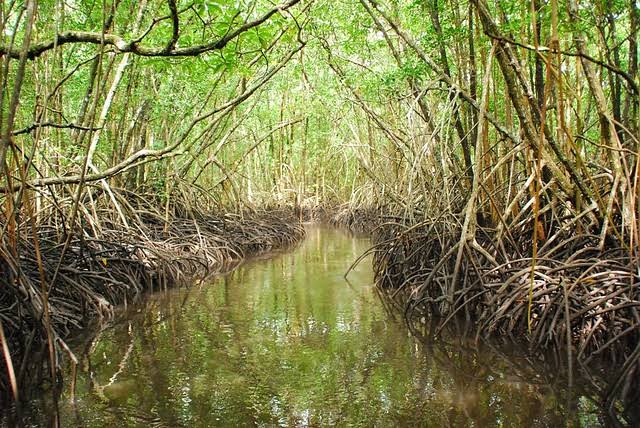KILIFI, Kenya, Jul, 12 – The southern ocean border of Kenya and Tanzania is dotted with thick hedges of mangroves – indispensable carbon sinks and spectacular ecosystems teeming with life – that appear to float dreamlike over creek beds and mudflats. These hardy trees and shrubs, and the communities that depend on them, are getting a major boost from UN-backed restoration plans that are also helping to reduce poverty and build economic resilience.
Mangroves are tropical marine forests with huge potential. They protect coastlines from erosion and storm surge; and provide food and shelter for a diverse array of wildlife, and nursery habitats for commercially important fish and shellfish.
They also fight climate change: the UN Environment Programme (UNEP) estimates that global mangrove forests sequester within their roots, trunks, and in the soil as much as 22.8 million tons of carbon each year.
While they provide valuable services for people and the planet, mangroves are in trouble. Along with climate change impacts such as rising sea levels and temperatures, mangrove forests are being depleted because their wood is valuable and prized by coastal communities as a prime source of timber for construction, fuel, and even medicines.
Rampant coastal urbanization, and unsustainable agriculture and aquaculture practices round out the long list of challenges.
But all hope is not lost! Sometimes, innovative partnerships can lead to sustainable solutions. Over the past three years, UN agencies, the Kenyan Government and other key partners have joined forces to launch several community-based conservation projects. They aim to help tackle poverty and deliver climate, biodiversity and local-level benefits to communities on the Kenyan coast.
Alongside UNEP, the Kenya Forest Service, the Kenya Marine and Fisheries Research Institute and partners recently inaugurated the Vanga Blue Forests Project in coastal Kwale County’s Vanga Bay (south of Mombasa), a groundbreaking initiative to trade carbon credits from mangrove conservation and restoration.
Vanga Blue’s sister project is in nearby Gazi Bay. Launched two years ago, this first-of-its-kind initiative, known as Mikoko Pamoja (‘Mangroves Together’), raises money by selling carbon credits to people and organizations eager to shrink their carbon footprint, through the Scottish charity ACES.
This project supports planting and conservation of mangrove trees. The payments for ‘mangrove carbon’ are used to benefit the local community.
Mwanarusi Mwafrika, the coordinator of Vanga Blue Forests, told UN News that some animal species like dugongs (marine mammals that are cousins of similarly threatened manatees) had begun disappearing. Now, they are coming back. Also, fishermen report of larger catches. This is because of the environment conservation efforts that we employed with the locals.”
The Vanga Blue Forests project focuses on conservation of the trees, as the locals have already planted the seedlings. It benefits about 9,000 residents of the villages of Vanga, Jimbo and Kiwegu. The villages form ‘VAJIKI’, a community forest association that oversees 460 hectares of forest land. Jimbo Village has established a nursery with 30,000 viable mangrove seedlings.
Harith Mohamed is the secretary of the community association, and he believes that conservation is the way forward.
“If you disturb the equilibrium [between] mangrove and terrestrial forests then there will be consequences,” he told UN News, and explained: “Terrestrial forests are uphill, and the mangroves are down along the water. So, it’s important to conserve these forests to prevent flooding because if the sea level rises, then the farms cannot be worked.”
The Vanga Blue Forests project supports community sustainable development processes that address education, health, and water and sanitation needs. In the short time since it was launched, some five hectares of mangroves have been restored, and that trajectory is expected to continue.
Moreover, Vanga Blue has set in motion vital projects that will enhance the lives and livelihoods of thousands of people in local fishing communities. For example, a nursery school has been rehabilitated and a hospital has been revamped with new equipment. Local sanitation projects are now under way.
Like the ocean, mangroves are massive carbon sinks. Compared to other terrestrial trees and forests, a single mangrove forest has a tenfold ability to suck in carbon emissions. Protecting and enhancing these forests removes and keeps carbon dioxide out of the atmosphere.
They also promote resilience to climate change, according to Florian Lux of the Go Blue Project, a third blue growth initiative underway along Kenya’s southern coast, which is being implemented by UNEP and UN-HABITAT and sponsored by the European Union.
“I’m pleased that the Go Blue Project has a mangrove restoration component. [Protection and sustainable use of mangroves provides] lots of possibilities for conserving the environment as well as being beneficial to the local villagers. Carbon sequestration does provide resilience in communities along the oceans,” he told UN News.
The Go Blue Project, a joint initiative to advance a sustainable blue economy across all six counties in Kenya’s coastal region, focuses on helping cities and towns cope with the impacts of climate change. Among others, the programme aims to harness important coastal and marine resources to bring jobs to over 3,000 youth and women.
Goodluck Mbaga, an environmentalist and conservationist in Kilifi County, reiterated the importance of being mindful of the health of the ocean.
“There’s a need to embrace conservation especially of the marine environment. There’s a lot of potential within the ocean as an alternative means of sustenance. There is more to reap from the ocean than the terrestrial activities in life,” he told UN News, echoing UNEP’s plea that rather than depleting or polluting these resources, we must develop ways in which to harness and protect them.
Want to send us a story? Contact Shahidi News Tel: +254115512797 (Mobile & WhatsApp)


